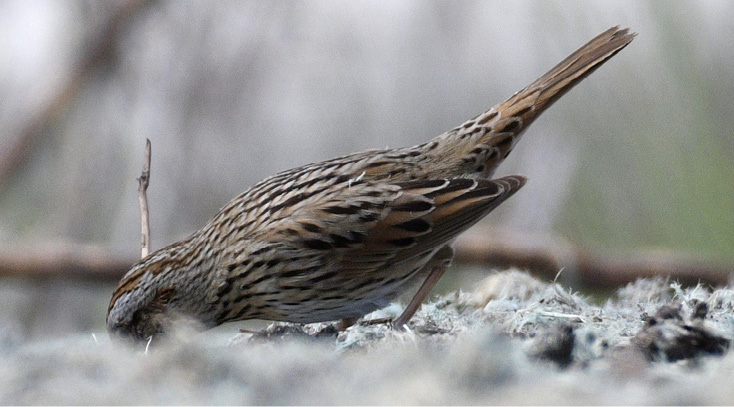Wayne R. Petersen

DAVID CLAPP
October is arguably the best month in the year to observe sparrows in Massachusetts. The combination of species diversity and overall sparrow abundance in mid fall makes October a superb time to search for sparrows in weedy fields, community gardens, roadside thickets, saltmarsh edges, and even such unlikely locations as unkept lawns, city parks, and cemeteries. If there is a negative aspect to sparrow watching, it is because many sparrows are nondescript, brown and streaky, and frequently shy or difficult to observe closely. Most to the point, a number of species closely resemble one another, often making their identification challenging.
It is obvious that this month’s mystery species is a sparrow. Although other species are brownish and streaky, most have other distinguishing features that will separate them from sparrows. American Pipits are slimmer with relatively plain, unstreaked backs, have longer and thinner legs, and a finer pointed bill when it is visible. Female and immature Purple Finches and House Finches are heavily streaked like some sparrows; however, like most finch species, they have chunkier bodies, shorter, prominently notched tails, thicker necks, and blockier heads. A final species that occasionally gets mistaken for a sparrow is the female Red-winged Blackbird. Though it is larger than any sparrow, its heavily streaked plumage, sharp-pointed bill, and buffy eyebrow stripe should be enough to distinguish it. There are a few other small streaky bird species that do not resemble sparrows as closely as pipits, finches, and redwings.
With the knowledge that the mystery species is a sparrow, the features to focus on are the crisply streaked breast, sides, and back, the relatively long tail, and—especially in the web image—the broad, light gray supercilium, the hint of a buffy wash on the crisply streaked breast, and the thin dark stripes on the back. The prominent streaks on the breast and flanks eliminate several other sparrow species: American Tree, Chipping, Clay-colored, Field, Lark, Swamp, Grasshopper, Dark-eyed Junco, White-throated, and White-crowned. Many of the small, streak-breasted grassland and saltmarsh sparrows are notably short tailed, or else have distinctive facial patterns or obvious white stripes on their backs that remove them as possibilities, e.g., LeConte’s, Nelson’s, Saltmarsh, and Seaside.
With many sparrow species now eliminated, only Savannah, Song, Lincoln’s, and Fox sparrows remain as viable identification candidates. Savannah Sparrows have a shorter notched tail, a strong eyeline, a prominent mustache stripe, and heavier streaks on the sides. Fox Sparrows, in addition to their foxy coloration, are chunky and heavily streaked on the underparts, exhibit narrow whitish wing bars, and have a distinct pale gray collar on the hindneck. This reduces the final choice to either Song or Lincoln’s sparrow. The ubiquitous Song Sparrow always displays a prominent large spot in the middle of its otherwise coarsely streaked breast, distinct dark malar stripes at the edges of its chin, smudgy dark stripes on its back, and a fairly long, rounded tail. With these final three possibilities eliminated, the mystery sparrow turns out to be a Lincoln’s Sparrow (Melospiza lincolnii), a fact highlighted by the fine stripes on its breast and sides, the buffy wash on its breast in the web image, and the thin black stripes on its back.
Lincoln’s Sparrows are relatively shy and uncommon spring migrants but are sometimes fairly common fall migrants throughout Massachusetts in weedy fields and thicket edges, where they regularly associate with other sparrow species.
David Clapp photographed this Lincoln’s Sparrow feeding in a hydroseeded area at the Provincetown Airport in Provincetown, Barnstable County, on May 17, 2020.
Wayne R. Petersen